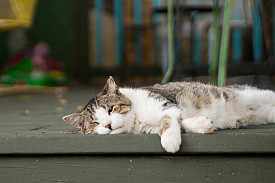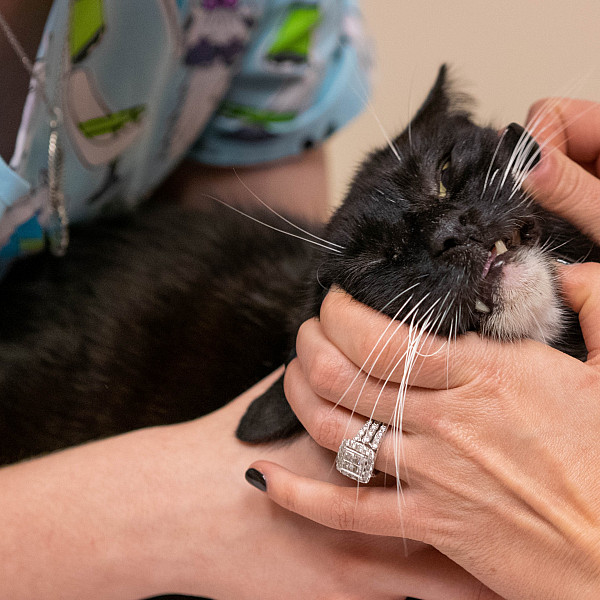News
Dogs Are Man’s Best Friend, but Cats Are a Pirate’s First Mate
April 11, 2021
April 11, 2021
Open gallery

In 2010, in the midst of working on her capstone project, sociology major Alex Brown ’11 learned about trap–neuter–return (TNR), a humane approach to addressing nondomesticated communities of cats. By safely trapping the animal, spaying or neutering them, and then returning them to their original area of residence, one can manage feral cat populations and reduce their numbers over a period of time without euthanization; the catch-and-kill method has proved to be futile considering that without ending the breeding cycle, feral cat populations will continue to reproduce. The TNR method can save cat lives, address community concerns, reduce complaints about feral cats, and stop the breeding cycle, thereby improving the existence between outdoor cats and humans in shared environments. Brown knew it had been successful at other university campuses, so she decided to try it at Southwestern. However, she didn’t realize the extent of the issue until she began.
Once Brown started regular feeding in one area, she realized that the problem was substantial and the overpopulation of the feral cats was significant. Campus administration had concerns about what the cats meant for pest control and maintenance because the cats loved to go under campus buildings, either through existing portals or by digging new entrances and egresses, possibly compromising the building’s foundational integrity, not to mention the detriment to the health of the kittens birthed in these dangerous areas. A solution was needed—quickly.
So with the help of Southwestern faculty and staff, the TNR team connected with Georgetown Animal Outreach (GAO), a local rescue group, and the Georgetown City Animal Shelter, and the cats were gradually trapped, neutered or spayed, and returned to campus by the end of the 2010–2011 academic year. All seemed well, thanks to the efforts of Brown and the community who worked to trap, neuter, and return the cats on campus. The work that Brown and others in the community did started in 2010, and shortly after, an official club was founded in 2011. And so goes the origin story of Cat Partners of Southwestern University (CPSU).
However, it can be said that there is a second origin story involving Faculty Administrative Assistant Kelly Lessard, a few science faculty members, and a particularly evasive Russian blue dubbed Gray Mama, all of whom arguably made CPSU what it is today.
In the summer of 2014, Lessard had an office in what is now known as the Fondren–Jones Science Center. During summer break, the campus was sparsely populated, so when she, Professor of Chemistry Emily Niemeyer, and Professor of Physics Steve Alexander noticed the hungry-looking gray cat hanging around the
building, they became concerned. At the time, CPSU was an existing organization but was not feeding any cats in that area of campus. So Lessard reached out to Professor of Religion Laura Hobgood, who was involved with GAO, and Ben Nava, Physical Plant staff and reputed animal whisperer. They, in turn, directed her to Professor of Political Science Shannon Mariotti, the advisor of CPSU at the time. Lessard began to feed Gray Mama, making plans to care for her health and trap her for TNR, and from that moment on, she was fully invested in the care of the cats on campus. After the summer of 2014, she became the advisor when Mariotti asked her to take over. This proved to be just in time because the following fall semester, two litters of kittens were birthed, a foreshadowing of the many, many, many kittens to come in the future, most of which can be attributed to Gray Mama. The period of time between the end of Brown’s TNR efforts in 2011 and the restart of TNR efforts in 2014 gave the campus cat population time to repopulate and get out of control.
The matriarch of the campus cats, Gray Mama is infamous for her evasive tactics, as she was not successfully TNRed until March 2017, but not for lack of trying. In
And so CPSU’s TNR efforts were reborn and revitalized. A new club constitution was created, explaining that their object is to “care for all free-roaming cats on campus, both stray and feral, by following the proven formula of trap–neuter–return (TNR),” and the CPSU we know and love today came to fruition.
A significant characteristic of the club is how many people have been involved, have contributed over the years, and how the club is. Currently, the club has about 25 active student feeders in addition to staff and faculty, as well as a substantial email list of others invested in the well-being of the cats. Still, CPSU President Hannah Roark ’21 declares that they are still in need of new volunteers. Her introduction to CPSU was characteristic for its origin: she got involved thanks to a friend who asked her to be on the executive team. She relates, “I think we’re an excellent example of how Southwestern creates such a strong sense of community. We’ve really all bonded together over our love of these cats.” And when asked about her favorite cat, Roark reveals her affinity for Mister Squinty—a white-bellied gray tabby—and his angry eyes.
Unfortunately, Mister Squinty has a congenital disorder caused by his eyelash hair
There is no doubt that Mister Squinty is the favorite of many; however, he has some competition from an up-and-coming orange tabby, Pumpkin, who has recently taken up residence under the steps of Mabee Residence Hall. Although he is only a recent addition to the family since the beginning of the fall 2020 semester, he is already adored by many students who live in the dorm and is the subject of a proposal being coordinated by CPSU to present to Southwestern administrators to create a new feeding station just for him outside of Mabee Residence Hall.
Currently, CPSU has three feeding stations around the campus, serving a total of eight cats, but this proposal will request to have a new station installed just for
Pumpkin. Although he is well taken care of by the students of Mabee and fed often, CPSU wants to formally take over this responsibility to ensure it is done regularly and properly. By having a designated feeding station and assigning volunteer feeders to it, CPSU could ensure that he is fed regularly and only in the morning. This last part is extremely important: when well-meaning students leave food out for him at night, it can attract other nocturnal critters who would love to get their paws on some of his tasty cat food. This is, for obvious reasons, a concern of campus administrators, and CPSU hopes they can resolve these issues by creating this feeding station and educating students on the proper way to feed him. Catching him and giving him to the Georgetown Animal Shelter is a poor option, not just because his status as an ear-notched community cat means there’s a substantial chance he could be put down but also because he seems to have taken a page from the book of Gray Mama and has evaded all efforts to trap him.
In a time of great uncertainty and hardship like now, we’re especially reminded of the true nature of the human experience and that at times, it can be one of sorrow and suffering. For students, being away from home can be stressful, with many on-campus students missing their family pets. CPSU serves as a way for those students and others to be a part of a community with a clear intent: care for the cats. And in caring for the cats, we care for ourselves and each other. This sentiment is beautifully described by Lessard:
The campus cats are the ultimate reminder that SU is both a community and a tiny part of the larger natural world, and [they] give us opportunities to care for
Other information
To make a financial donation to Cat Partners, go to the Southwestern University Giving page. You must specifically designate the money to go to Cat Partners (CPSU) by selecting “other” as the designation and typing “Cat Partners” as the additional designation.
CPSU also takes gifts-in-kind, such as dry or wet cat food. Many friends have donated cat food that their pet didn’t like or need. The campus cats will eat any kind of food.
CPSU asks that if you see kittens or an unidentified cat on campus, please report it to any CPSU officer or the advisor, listed here, take a picture, and give the exact location. CPSU has the resources necessary for safely trapping the animals and subsequently caring for them, and your report helps keep the cat population on campus in check.
Find out more about CPSU by visiting their Instagram @SU_cat_partners or contacting an officer on the home page of their website. To get involved, email the CPSU advisor and/or president.
















